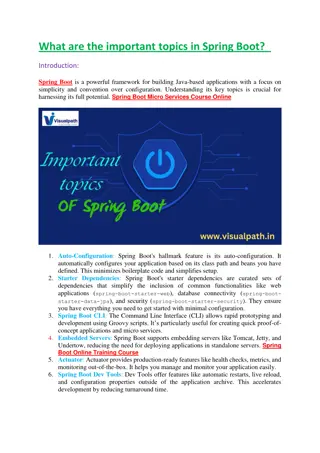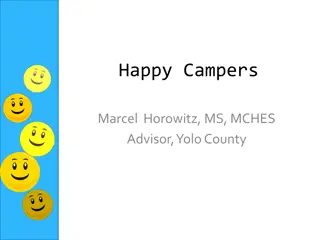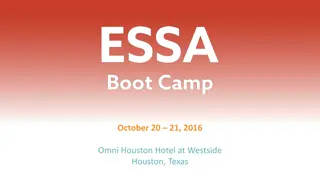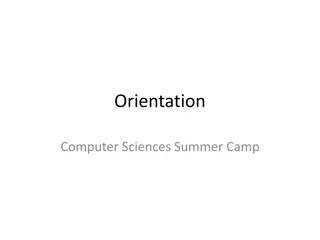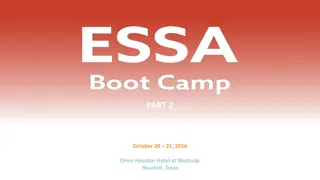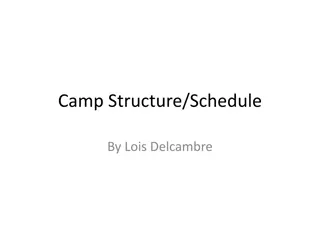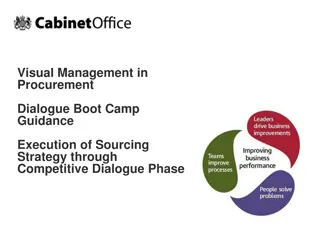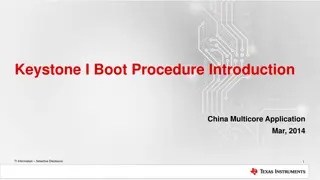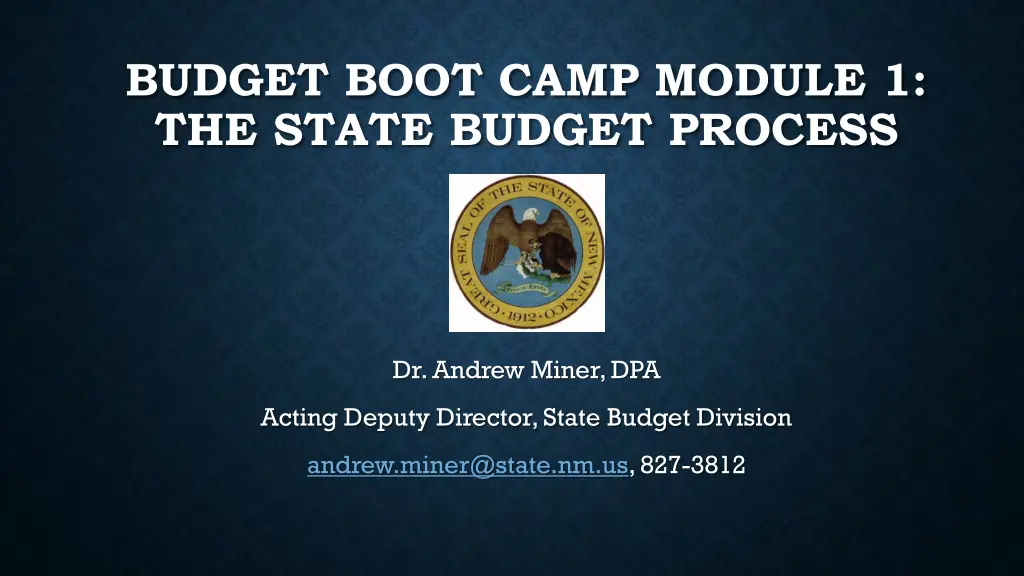
Understanding State Budget Processes in New Mexico
Explore the State Budget Division and its role in managing budget activities in New Mexico. Learn about the state budget process, budget management, the SHARE system, budgeting history, and more. Ideal for new budget analysts looking to enhance their knowledge of state budgeting.
Download Presentation

Please find below an Image/Link to download the presentation.
The content on the website is provided AS IS for your information and personal use only. It may not be sold, licensed, or shared on other websites without obtaining consent from the author. If you encounter any issues during the download, it is possible that the publisher has removed the file from their server.
You are allowed to download the files provided on this website for personal or commercial use, subject to the condition that they are used lawfully. All files are the property of their respective owners.
The content on the website is provided AS IS for your information and personal use only. It may not be sold, licensed, or shared on other websites without obtaining consent from the author.
E N D
Presentation Transcript
BUDGET BOOT CAMP MODULE 1: THE STATE BUDGET PROCESS Dr. Andrew Miner, DPA Acting Deputy Director, State Budget Division andrew.miner@state.nm.us, 827-3812
COURSE OVERVIEW Targeted for new budget analysts, but everyone wishing to increase their knowledge of state budgeting in New Mexico is welcome 1. State Budget Process Lots of background and context to establish the environment in which budget analysts do their jobs 2. Budget Management Documents Authority and types of budget adjustments, nonrecurring appropriations, demonstrations of how to submit 3. The SHARE System Explanation and demonstrations of creating budget journals and running useful reports, and applications for these 4. Budgeting History and Scholarship How has public budgeting changed over time, how does budgeting differ across states, what influences the budget process? SBD holds separate trainings for budget request and operating budget submission won t get into many details here. Also, new budget system training starting in late June. Please type your questions in chat we have plenty of time. Please make sure video and mic are off Good idea to abbreviation meanings the first time you see them. 2
INTRODUCTION TO THE STATE BUDGET DIVISION SBD is the Governor s/Executive Budget Office, part of the Department of Finance and Administration (DFA) Provide budget and policy information, analysis, and recommendations to Executive Branch leadership (i.e. DFA management, Governor s Office, agency heads) Executive budget recommendation Testify at budget hearings Fiscal impact reports and policy recommendations for legislation Manage state budget activities throughout the fiscal year Approve Operating Budget submissions Process Budget Adjustment Requests and other documents Review proposed HR actions and contracts for budget soundness Promote efficiency in government operations and effective use of taxpayer dollars Direct performance management process in collaboration with Legislative Finance Committee Only the SBD Director is appointed, all other staff are classified 3
State Budget Division June 2021 Cinthia Martinez Acting Division Director/DFA Deputy Secretary Capital Outlay Bureau Wesley Billingsley, Director Andrew Miner Acting Deputy Director/Economic and Natural Resources Lead Tonantzin Roybal Executive Capital Analyst Ryan Serrano Executive Capital Analyst Nicole Macias Principal Analyst Meribeth Densmore Health and Justice Team Lead Michael Regensberg Human Services and Public Safety Team Lead Vacant Sarah Delarosa Office Manager Simon Miller Principal Analyst Cyndi Montoya Principal Analyst Office Manager Brian Chavez Senior Analyst Jeremy Perea Senior Analyst Diego Jimenez Senior Analyst Donna Rivera Senior Analyst Vacant Senior Analyst (K-12 Education)
OTHER STATE BUDGET ACTORS DFA Financial Control Division Process general fund allotments Work with SBD and agencies to resolve budget and accounting issues Governor s Office and Cabinet Directors Work with SBD and agencies to address Executive budget priorities Legislative Finance Committee Legislature s budget office also produce a budget recommendation Review agency budget activities (including BARs) and performance Other legislative committees House Appropriations and Finance (HAFC), Senate Finance (SFC), Legislative Education Study Committee (LESC) Consensus Revenue Estimation Group (CREG) DFA, LFC, TRD, and DOT economists Outside of state government Advocacy groups, schools, local governments, etc. 5
THE STATE BUDGET CYCLE July/August: Appropriation request preparation by agencies (due Sept. 1 by statute) SBD and Governor s Office may meet with agencies to discuss budget needs and executive priorities SBD and LFC may issue budget guidelines to agencies SBD provides training and instructions, facilitates BRS and PBB system use, troubleshoots technical problems and otherwise assists as needed September December: SBD and LFC prepare budget recommendations LFC holds fall budget hearings for all agencies, discuss their requests Review submissions for technical accuracy, request more info from agencies, meet as needed Finalize and publish recommendations according to executive (SBD) and legislative (LFC) priorities in early January New Mexico is one of only a few states where the executive and legislative branches release concurrent budget recommendations October: Agencies request nonrecurring appropriations, Section 4 special language, and budget adjustment authority language for incorporation into executive and LFC recommendations 6
THE STATE BUDGET CYCLE January March: Legislative session, passage of the General Appropriations Act (GAA) Alternate 60 day (odd years) and 30 day (even years) sessions Budget hearings at House Appropriations and Finance Committee (HAFC) Committee adopts LFC or executive recommendation or requests reconciliation Concurrently SFC holds informational budget hearings with selected agencies House passes budget bill (usually HB2) and moves to Senate Executive agencies work with SBD to submit Senate amendment requests, non-Executive branch agencies may request amendments independently Once budget passes Senate and concurred in House, SBD and Governor s Office work together to draft line-item vetoes. Generally, governor may veto appropriations or language, but may not change appropriations or create new language through deletion April: agencies prepare operating budget (due May 1 by statute) SBD issues guidelines based on enacted budget and provides training, assists as needed May begin to budget nonrecurring appropriations as authorized in budget bill May/June: SBD reviews operating budget submissions for accuracy, prepares and posts budget journals in SHARE by July 1 for use in new FY 7
STRUCTURE OF THE STATE BUDGET: ORGANIZATION HIERARCHY Business Unit (BU) state agency 5 digit code in SHARE, often shortened to first 3 digits First number refers to functional group of agencies 21800Administrative Office of the Courts 34100Department of Finance and Administration 46500Gaming Control Board 66500Department of Health 77000Department of Corrections 92400Public Education Department 1Legislative Agencies 6Health and Human Services 2Judicial Agencies 7Public Safety 3General Control 8Transportation 4Commerce & Industry 9Education 5Natural Resources Program code (P-code) highest division of agency Small agencies only have one P-code, but must have one Budget is appropriated by the legislature at P-code level 4 digit code in SHARE (Pxxx), found in Department field Usually correspond to Divisions in an agency, but some exceptions DFA P-codes P541 Policy Development, Fiscal Oversight and Budget P542 Program Support P543 P544 Community Development / Local Govt. Assistance (LGD) Fiscal Management & Oversight (FCD) 8
STRUCTURE OF THE STATE BUDGET: ORGANIZATION HIERARCHY Fund Accounts within agencies that receive revenues and register expenditures Every agency has at least one unique fund, some agencies have many Funds can have budget in multiple P-codes, revenue and expenditure categories Some funds are established in statute and have strictly defined revenues and expenditures Legislature does not directly appropriate by fund, but agencies must establish budget in funds, which should roll up to their total appropriated budget 5 digit code in SHARE (Fund field), generally first 3 digits denote a high level fund, with last 2 digits (if not zeroes) denoting a lower level sub-fund Some Environment Dept. Funds 06400General Operating Fund 33700Rural Infrastructure Revolving Loan Fund 9 33900Hazardous Waste Fund 99000Corrective Action Fund
STRUCTURE OF THE STATE BUDGET: ORGANIZATION HIERARCHY 10 digit department code (1200000000) Optional: Used by larger agencies to budget by subdivisions of P-codes such as bureaus, units, offices SBD does not control but department-level budgets must roll up to P-code Z-code (ZE5011) Used to budget nonrecurring (one-time) appropriations Created every year after passage of budget bill Also found in department field in SHARE A-code (A020074) Used to budget capital projects, regulated by DFA s Capital Outlay Bureau Also found in department field Larger agencies may further divide their budgets through such fields as subaccounts or reporting categories as needed 10
STRUCTURE OF THE STATE BUDGET: REVENUE CATEGORIES General Fund (GF). Revenue code 499105 State income collected from various sales and income taxes. Most strictly controlled and appropriated by legislature. Cannot increase during the fiscal year. Distributed to agencies by FCD generally in 1/12 allotments New money : increased projected GF revenue over previous year estimated by CREG. How to spend it is the subject of intense debate during budget formulation in the legislative session. Other State Funds (OSF) Recurring revenue agencies receive from permits, fees, leases, interest income, etc. Agencies have limited authority to increase budget during FY through BARs Many different revenue codes such as Interest on Investments (441201) or Land Rental or Lease (442103) Fund Balance Nonrecurring OSF revenue (amounts sitting in agency special revenue funds) Appropriated as part of OSF total in the budget bill, but budgeted separately in SHARE Budgeted with equity codes such as 325900 (restricted fund balance) or 328900 (unassigned fund balance) 11
STRUCTURE OF THE STATE BUDGET: REVENUE CATEGORIES Transfer Revenue Transfers received from various sources another state agency, another program in same agency, or outside entity Reciprocal transfers Money received to perform a service, generally established through an MOU, grant, etc. Expended as 300 or 400 expense 451909: transfer revenue code if money was originally federal 425909: transfer revenue code for all other original funding sources Nonreciprocal transfers Money received with no strings attached, directed transfers by legislature or within agency, often from a segregated special revenue fund to an operating fund 499905: revenue received from another state agency 499906: revenue received from within the same agency Nonreciprocal transfer revenue must balance to a 500 category transfer expenditure (eliminates double accounting) Limited authority to increase during FY, similar to OSF Federal Funds most common revenue code 451903 (direct grant) Money received from the federal government through grants or other funding distributions Amounts are listed in the budget bill but those within agencies operating budgets are technically not appropriated by the legislature Broad authority to increase during FY if agency can show new funds have been awarded 12
STRUCTURE OF THE STATE BUDGET: EXPENDITURE CATEGORIES Appropriated and budgeted by 3-digit category total; agencies spend by 6-digit line items within each category Budget actuals and requested amounts are reported with 6-digit codes to aid in budget planning and recommendations Personal Services and Employee Benefits (PSEB 200s) Costs associated with salaries, employer share of benefits such as insurance and retirement contributions, and costs such as unemployment and workers compensation 520300: Permanent Full-Time Salaries 521100: Employer Group Insurance Costs Contracts (300s) Contract expenses for services performed by various entities private firms, nonprofits, other agencies 535200: Professional Services Contracts 535400: Agency Audit Contract (dictated by schedule) 13
STRUCTURE OF THE STATE BUDGET: EXPENDITURE CATEGORIES Other Costs (400s) Basically everything else travel, utilities, supplies, grants, maintenance, etc. Some are fixed costs determined by rate schedules issued by GSD and DoIT Examples of 400 Category Line Items 542200Instate Meals and Lodging 545710DoIT HCM Assessment Fee 542800Transportation - Pool 546320Utilities Electricity 544100Office Supplies 547450Grants to Other Agencies Other Financing Uses (500s) Nonreciprocal transfers to other agencies, within agency, or to a component unit 555100: Transfer to another agency 555106: Transfer within the same agency (to another fund / P-code) 555200: Transfer to a component unit of the state (not budgeted in SHARE universities) Recipient should recognize as transfer revenue 14
STRUCTURE OF THE STATE BUDGET: FTE AND PERSONNEL COSTS (200S) Types of Full-Time Equivalent (FTE) Positions Permanent (salary line 520300 for full-time, 520400 for part-time): Funding source is stable, not going away, such as general fund or permanent special revenue funds Term (salary line 520200): funded by other sources that may go away from year to year such as federal grants, need to be reauthorized every year based on available budget Temporary (salary line 520500: Positions for fixed period of time (6 months 1 year), are generally not eligible for all benefits Exempt (salary line 520100: Appointed or elected positions not part of the classified civil service. Do receive benefits, generally grouped with perm positions for FTE counts FTE totals are no longer listed in the budget bill but agencies do report them and need to request creation of new positions (except temporary) through budget process 15
STRUCTURE OF THE STATE BUDGET: FTE AND PERSONNEL COSTS (200S) Certain line item costs are formula-driven and determined by salary costs 521200: Retirement (employer pension contributions) 521300: FICA 521700: Retiree Healthcare 521100: Employer insurance costs. Determined by employee insurance plans (single, family, etc.) and salary levels (employees with higher salaries pay a higher percentage of insurance costs) Vacancy rates Most agencies should not budget full cost of personnel and benefits for all authorized FTE due to number of vacant positions and turnover Apply a reasonable vacancy rate based on past and current trends to more accurately reflect personnel costs. Apply to salary and related benefit lines. 16 Apply 10% vacancy rate = budget 90% of total projected personnel costs
DIVISION OF THE NEW MEXICO STATE BUDGET FY20 General Fund Operating Budget FY20 Total Funds Operating Budget General Control, $147,535.6 $359,016.7, Judicial Judicial, $318,833.0 Legislative, $20,731.6 Higher Education, $867,043.3 $20,731.6, Legislative $919,840.0, Higher Education Commerce and Industry , $62,622.1 $1,746,340.5, General Control $242,215.2, Commerce and Industry $3,771,579.7, K-12 Education Ag, Energy and Natural Resources, $75,638.6 Health and Human Services, $1,871,387.0 $222,296.4, Ag, Energy and Natural Resources K-12 Education, $3,251,191.7 Public Safety, $468,659.3 Transportation, $0.0 $920,307.5, Transportation $599,204.5, Public Safety FY20 Operating Budget by Revenue Source Transfers 3% $8,881,208.9, Health and Human Services Other State Funds 22% General Fund 36% 17 Federal Funds 39%
THE GENERAL APPROPRIATIONS ACT (GAA, HB2) Good idea to have 3 GAAs always available: last year, current year, and next year (once passed) Sections 1-3: Standard front material, definitions, general provisions, BAR authority for federal increases and other grants Section 4 Every agency s recurring operating budget by program, broken out by funding source and expenditure category. Dollars truncated to thousands with one decimal point (75.9 = $75,900) 18
THE GENERAL APPROPRIATIONS ACT (GAA, HB2) Section 4, continued Language may be included to identify source of transferred funds, earmark specific funding, or otherwise stipulate use of funds or powers of the agency Subset of agency/program s performance measures and approved targets 19
THE GENERAL APPROPRIATIONS ACT (GAA, HB2) Nonrecurring budget sections (one-time funding) Section 5: Special appropriations generally valid during remainder of current FY and all of next FY. Language details specific purpose, funding in appropriate column. Section 6: Supplemental and deficiency appropriations generally valid during remainder of current FY (deficiencies fix holes in previous FYs) 20
THE GENERAL APPROPRIATIONS ACT (GAA, HB2) Nonrecurring budget sections, continued Section 7: IT project appropriations generally valid for remainder of current FY and 2 more years. Usually funded by computer systems enhancement fund (revenue from GF). Funds can t be budgeted/expended until released by Project Certification Committee (PCC) Appropriations from these sections may be reauthorized through language if not all funding has been spent in allotted period. Agencies are generally free to budget these appropriations across expenditure categories at their discretion to acoomplish the purpose of the appropriation. 21
THE GENERAL APPROPRIATIONS ACT (GAA, HB2) Compensation Section (when included - often Section 8) Contains different appropriations of general fund to provide salary and/or benefit increases to state employees May stipulate different percent raises for different groups of employees Agencies may increase other funding sources to pay for increased costs as well Usually appropriated to DFA, agencies budget as transfers first year, rolled into base budget in future years 22
THE GENERAL APPROPRIATIONS ACT (GAA) Budget Adjustment Request (BAR) Language sections (generally follow all appropriations) 1st section: additional BAR authority specific to certain agencies for remainder of current FY 2nd section: general BAR authority for all agencies and agency-specific authority for next FY Will be detailed further in Module 2 Transfers section General fund transfers to certain agencies and/or funds, generally not viewed as appropriations to expend the money 23
HOW TO CITE THE GAA AND OTHER LEGISLATION Laws 2020, 2nd Session, Chapter 83, Section 5, Item 120 Session is by election cycles, not year. Odd year = 1st session, even year = 2nd session Session implies regular session, otherwise 1stSpecial Session Every bill receives a chapter number after signed, use this instead of bill number Appropriations may be created in bills other than HB2 (usually one-time), use correct chapter number from corresponding bill when budgeting that appropriation 2021 junior budget bill (SB 377), Laws 2021, 1st Session, Chapter 140: Contains numerous appropriations for many state agencies, first half nonrecurring, 2nd half recurring Language may be identified by subsection in parentheses, such as Section 3 (I) FY22 GAA: Laws 2021, 1st Session, Chapter 137 24
INTERPRETING LANGUAGE IN THE GAA At times the GAA can include language that can be difficult for agencies to interpret, especially regarding how certain funding should be used Section 4 appropriation language or language directing how nonrecurring appropriations should be used Who should agencies contact if they need assistance in this regard? It is the State Budget Division s job to implement the GAA and they should be agencies first point of contact. SBD will have info on executive initiatives in the GAA. LFC can provide information on legislative initiatives in the GAA. Please coordinate w/ SBD. FCD can provide guidance on accounting-related language. 25
NEW MEXICO STATUTES NM OneSource Statute Lookup: https://nmonesource.com/nmos/en/nav.do Enter search terms (citation or keyword) and click result from dropdown State Budget Statutes: 6-3-1 through 6-3-25 NMSA 1978 Special Revenue Fund Statutes Important to know statutes detailing sources, eligible uses, and managerial authority (ability to increase budget) associated with each of your agency s special revenue funds 26
THE ACCOUNTABILITY IN GOVERNMENT ACT (AGA): 6-3A-1 THROUGH 6-3A-10 NMSA 1978 Establishes performance measure process for each agency in order to connect budget with agency performance Each performance measure has a type (output, explanatory, etc.) and a target, with numerical data that can be consistently measured and tracked from year to year Data is used by LFC to create agency report cards for public and legislative use (frequently used during legislative session hearings) AGA establishes process to revise measures, set targets, and report data each year Some agencies have separate performance staff, others have budget staff perform this role consult your management team 27
PERFORMANCE MEASURE CYCLE June 15: SBD issues guidelines to agencies to request changes to their measures for the next budget cycle year (June 2019: changes for FY21) July 15: Agencies submit requested changes to SBD and LFC Key agencies must also identify which measures they will report on quarterly in the current FY July/August: Agencies, SBD and LFC meet as needed to collaborate on requested changes and strive to come to consensus August 15: SBD issues final approved measures to agencies, incorporates changes into performance measure system Sept. 1: Agencies include requested targets for approved measures as part of their budget request. Legislative session: SBD and LFC analysts meet to discuss their target recommendations and strive to come to consensus Select measures and targets included in GAA
USEFUL WEBSITES State Budget Division: http://www.nmdfa.state.nm.us/Budget_Division.aspx Executive Budget Recommendation Appropriation Request Instructions and Forms Operating Budget Submission Instructions and Forms Budget Adjustment Request Instructions and Forms Performance Based Budgeting Instructions and Forms Legislative Finance Committee: https://nmlegis.gov/Entity/LFC/Default Session Publications: Appropriation Recommendations, Policy and Performance Analysis Evaluation Unit Publications (performance and program reviews) Finance Facts and other reference material Legislature: https://nmlegis.gov/ Bill Finder Committee Schedules and Agendas Webcasts 29
END OF MODULE 1 THE STATE BUDGET PROCESS 30


